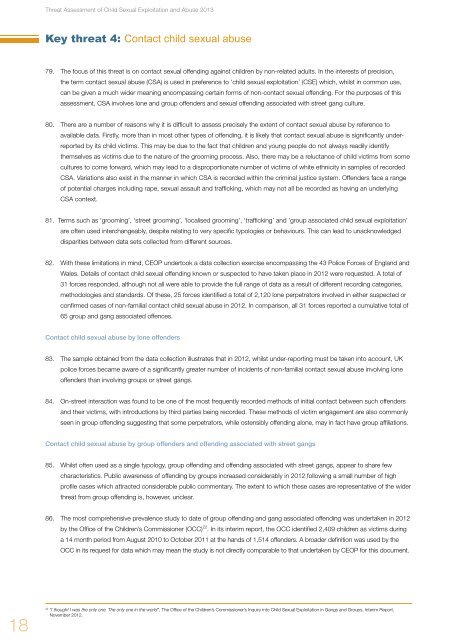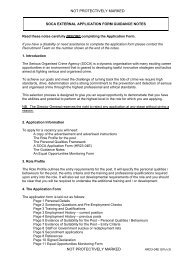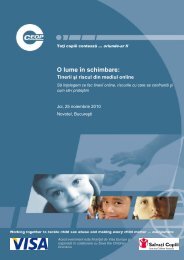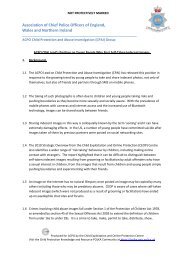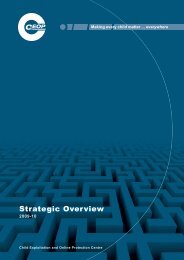Threat Assessment of Child Sexual Exploitation and Abuse - Ceop
Threat Assessment of Child Sexual Exploitation and Abuse - Ceop
Threat Assessment of Child Sexual Exploitation and Abuse - Ceop
Create successful ePaper yourself
Turn your PDF publications into a flip-book with our unique Google optimized e-Paper software.
<strong>Threat</strong> <strong>Assessment</strong> <strong>of</strong> <strong>Child</strong> <strong>Sexual</strong> <strong>Exploitation</strong> <strong>and</strong> <strong>Abuse</strong> 2013<br />
Key threat 4: Contact child sexual abuse<br />
79. The focus <strong>of</strong> this threat is on contact sexual <strong>of</strong>fending against children by non-related adults. In the interests <strong>of</strong> precision,<br />
the term contact sexual abuse (CSA) is used in preference to ‘child sexual exploitation’ (CSE) which, whilst in common use,<br />
can be given a much wider meaning encompassing certain forms <strong>of</strong> non-contact sexual <strong>of</strong>fending. For the purposes <strong>of</strong> this<br />
assessment, CSA involves lone <strong>and</strong> group <strong>of</strong>fenders <strong>and</strong> sexual <strong>of</strong>fending associated with street gang culture.<br />
80. There are a number <strong>of</strong> reasons why it is difficult to assess precisely the extent <strong>of</strong> contact sexual abuse by reference to<br />
available data. Firstly, more than in most other types <strong>of</strong> <strong>of</strong>fending, it is likely that contact sexual abuse is significantly underreported<br />
by its child victims. This may be due to the fact that children <strong>and</strong> young people do not always readily identify<br />
themselves as victims due to the nature <strong>of</strong> the grooming process. Also, there may be a reluctance <strong>of</strong> child victims from some<br />
cultures to come forward, which may lead to a disproportionate number <strong>of</strong> victims <strong>of</strong> white ethnicity in samples <strong>of</strong> recorded<br />
CSA. Variations also exist in the manner in which CSA is recorded within the criminal justice system. Offenders face a range<br />
<strong>of</strong> potential charges including rape, sexual assault <strong>and</strong> trafficking, which may not all be recorded as having an underlying<br />
CSA context.<br />
81. Terms such as ‘grooming’, ‘street grooming’, ‘localised grooming’, ‘trafficking’ <strong>and</strong> ‘group associated child sexual exploitation’<br />
are <strong>of</strong>ten used interchangeably, despite relating to very specific typologies or behaviours. This can lead to unacknowledged<br />
disparities between data sets collected from different sources.<br />
82. With these limitations in mind, CEOP undertook a data collection exercise encompassing the 43 Police Forces <strong>of</strong> Engl<strong>and</strong> <strong>and</strong><br />
Wales. Details <strong>of</strong> contact child sexual <strong>of</strong>fending known or suspected to have taken place in 2012 were requested. A total <strong>of</strong><br />
31 forces responded, although not all were able to provide the full range <strong>of</strong> data as a result <strong>of</strong> different recording categories,<br />
methodologies <strong>and</strong> st<strong>and</strong>ards. Of these, 25 forces identified a total <strong>of</strong> 2,120 lone perpetrators involved in either suspected or<br />
confirmed cases <strong>of</strong> non-familial contact child sexual abuse in 2012. In comparison, all 31 forces reported a cumulative total <strong>of</strong><br />
65 group <strong>and</strong> gang associated <strong>of</strong>fences.<br />
Contact child sexual abuse by lone <strong>of</strong>fenders<br />
83. The sample obtained from the data collection illustrates that in 2012, whilst under-reporting must be taken into account, UK<br />
police forces became aware <strong>of</strong> a significantly greater number <strong>of</strong> incidents <strong>of</strong> non-familial contact sexual abuse involving lone<br />
<strong>of</strong>fenders than involving groups or street gangs.<br />
84. On-street interaction was found to be one <strong>of</strong> the most frequently recorded methods <strong>of</strong> initial contact between such <strong>of</strong>fenders<br />
<strong>and</strong> their victims, with introductions by third parties being recorded. These methods <strong>of</strong> victim engagement are also commonly<br />
seen in group <strong>of</strong>fending suggesting that some perpetrators, while ostensibly <strong>of</strong>fending alone, may in fact have group affiliations.<br />
Contact child sexual abuse by group <strong>of</strong>fenders <strong>and</strong> <strong>of</strong>fending associated with street gangs<br />
85. Whilst <strong>of</strong>ten used as a single typology, group <strong>of</strong>fending <strong>and</strong> <strong>of</strong>fending associated with street gangs, appear to share few<br />
characteristics. Public awareness <strong>of</strong> <strong>of</strong>fending by groups increased considerably in 2012 following a small number <strong>of</strong> high<br />
pr<strong>of</strong>ile cases which attracted considerable public commentary. The extent to which these cases are representative <strong>of</strong> the wider<br />
threat from group <strong>of</strong>fending is, however, unclear.<br />
86. The most comprehensive prevalence study to date <strong>of</strong> group <strong>of</strong>fending <strong>and</strong> gang associated <strong>of</strong>fending was undertaken in 2012<br />
by the Office <strong>of</strong> the <strong>Child</strong>ren’s Commissioner (OCC) 22 . In its interim report, the OCC identified 2,409 children as victims during<br />
a 14 month period from August 2010 to October 2011 at the h<strong>and</strong>s <strong>of</strong> 1,514 <strong>of</strong>fenders. A broader definition was used by the<br />
OCC in its request for data which may mean the study is not directly comparable to that undertaken by CEOP for this document.<br />
18<br />
22<br />
“I thought I was the only one. The only one in the world”, The Office <strong>of</strong> the <strong>Child</strong>ren’s Commissioner’s Inquiry into <strong>Child</strong> <strong>Sexual</strong> <strong>Exploitation</strong> in Gangs <strong>and</strong> Groups, Interim Report,<br />
November 2012.


